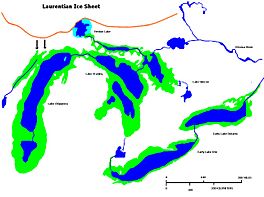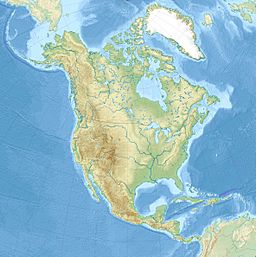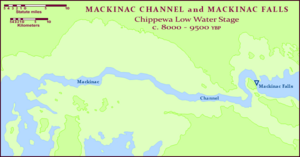Lake Stanley facts for kids
Quick facts for kids Lake Stanley |
|
|---|---|

Glacial Lakes Chippewa, Stanley, Early Erie and Early Ontario. Low level lake stages during the end of the Wisconsin Glacial era in North America. Based on Larsen map, 1987.
|
|
| Location | North America |
| Group | Great Lakes |
| Coordinates | 44°48′N 82°24′W / 44.8°N 82.4°W |
| Lake type | former lake |
| Etymology | George M. Stanley |
| Primary inflows | Lake Chippewa basin |
| Primary outflows | French River (Ontario) |
| Basin countries | Canada United States |
| Max. length | 241 mi (388 km) |
| Max. width | 57 mi (92 km) |
| Residence time | 1850 years in existence |
| Surface elevation | 476 ft (145 m) |
Lake Stanley was a huge ancient lake that existed about 10,000 years ago. It covered part of the area where Lake Huron is today. This lake was much lower than Lake Huron is now, about 70 meters (230 feet) deeper than the current lake's surface. It was fed by water from a large area, including where Lake Michigan is now.
Water from Lake Stanley flowed out through an area near what is now North Bay, Ontario. This ancient lake was an important part of the Great Lakes region's history.
Contents
Exploring Ancient Lake Stanley
Scientists have studied the old shoreline of Lake Stanley. This shoreline is now underwater. By looking at it, they can learn about what the environment was like long ago.
Underwater Discoveries
In 2009, researchers found something interesting. They described stones placed near a part of Lake Stanley's old shoreline. These stones are now deep underwater.
The scientists thought these stones might have been used for hunting. They suggested the stones could have been "drive lanes." These lanes would have helped guide caribou, a type of deer, into a trap for hunters.
How Lake Stanley Disappeared
Lake Stanley did not last forever. Around 8,500 years ago, the land began to change. These changes caused Lake Stanley to disappear.
Land Rising and Water Changes
The land in Canada, north of a special "tilt line," started to rise. This happened because the heavy glacier ice that once covered it had melted away. When the land rose, it blocked the water flowing out of Lake Stanley near North Bay.
As the outflow was blocked, the water level in the Lake Huron area began to rise. This rising water eventually covered the Mackinac Straits about 8,150 years ago. This event marked the end of Lake Stanley. The rising water then helped create the Lake Michigan-Lake Huron lake system we know today.
| North American Great Lakes |
|---|
| Lake Superior - Lake Michigan - Lake Huron - Lake Erie - Lake Ontario |



